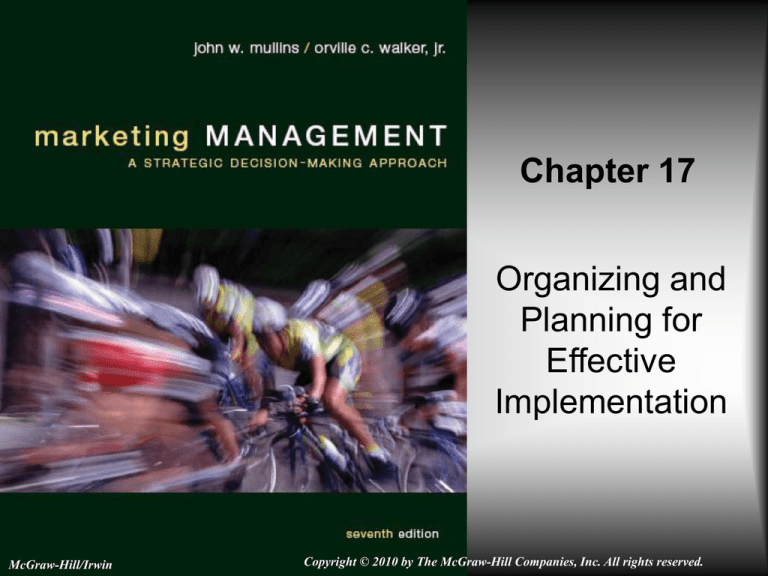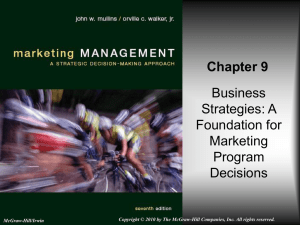
Chapter 17
Organizing and
Planning for
Effective
Implementation
McGraw-Hill/Irwin
Copyright © 2010 by The McGraw-Hill Companies, Inc. All rights reserved.
Designing Appropriate Administrative
Relationships
• Designing appropriate administrative
relationships for the implementation of
different competitive strategies:
– The degree of autonomy provided to each
business unit manager.
– The degree to which the business unit shares
functional programs and facilities with other
units.
– The manner in which the corporation
evaluates and rewards the performance of its
SBU managers.
17-2
Designing Appropriate Administrative
Relationships
• Business-unit autonomy
– Prospectors are likely to perform better on the
critical dimensions of new product success.
• Decentralized decision making allows the
managers closest to the market to make more
major decisions on their own.
• Managers will be more flexible and adaptable.
• Coordination problems across business units.
– Low-cost defender SBUs perform better on
ROI and cash flow by giving their managers
relatively little autonomy.
17-3
Designing Appropriate Administrative
Relationships
• Shared programs and facilities
– Some firms attempt to avoid the trade-off
between efficiency and adaptability by
designing relatively small, narrowly focused
units, but then having two or more units share
functional programs or facilities.
– Sharing resources can pose a problem for
prospector business units.
– Functional independence usually facilitates
good performance for prospector businesses.
17-4
Designing Appropriate Administrative
Relationships
• Evaluation and reward systems
– For defenders in relatively mature markets, operating
efficiency and profitability tend to be the most
important objectives.
– Basing too large a portion of managers’ rewards on
current profitability may cause problems for
prospectors.
– Systems that place more emphasis on sales volume
or market share objectives, or on the percentage of
volume generated by new products, may be more
appropriate for prospectors.
17-5
Designing Appropriate Organizational
Structures and Processes
• Successful implementation of a given
strategy is more likely when the business:
– Has the functional competencies demanded
by its strategy and supports them with
substantial resources relative to competitors,
– Is organized suitably for its technical, market,
and competitive environment, and
– Has developed appropriate mechanisms for
coordinating efforts and resolving conflicts
across functional departments.
17-6
Designing Appropriate Organizational
Structures and Processes
• Functional competencies and resource
allocation
– Competence in marketing, sales, product
R&D, and engineering are critical to the
success of prospector businesses.
– In low-cost defender businesses the
functional areas most directly related to
operating efficiency.
17-7
Designing Appropriate Organizational
Structures and Processes
• Service organizations
– Competence in human resource development
is more crucial for service businesses
pursuing prospector strategies than for those
focused primarily on efficiency and low cost.
– Personnel management is an important
adjunct to the production and marketing
efforts of high-contact service organizations.
17-8
Designing Appropriate Organizational
Structures and Processes
• Organizational structures: Variables
– Formalization is the degree to which formal
rules and standard policies and procedures
govern decisions and working relationships.
– Centralization refers to the location of
decision authority and control within an
organization’s hierarchy.
– Specialization refers to the division of tasks
and activities across positions within the
organizational unit.
17-9
Functional Organization of an SBU and
Its Marketing Department
17-10
Designing Appropriate Organizational
Structures and Processes
• Functional organizations
– The simplest and most bureaucratic design.
– This is the most centralized and formalized
organization form and relies primarily on
hierarchical mechanisms for resolving
conflicts across functional areas.
17-11
A Marketing Department with a
Product Management Organization
17-12
Designing Appropriate Organizational
Structures and Processes
• Product management organizations
– This structure decentralizes decision making
while increasing the amount of product
specialization.
– Although the product managers are
responsible for obtaining cooperation from
other functional areas both within and outside
the marketing department, they have no
formal authority over these areas.
17-13
A Marketing Department with a
Market Management Organization
17-14
Designing Appropriate Organizational
Structures and Processes
• Market management organizations
– In some industries an SBU may market a
single product to a large number of markets
where customers have very different
requirements and preferences.
– The intermediaries and marketing activities
involved in selling to the different markets are
so different that it makes sense to have
separate market managers in charge of each.
17-15
Designing Appropriate Organizational
Structures and Processes
• Matrix organizations
– The least bureaucratic or centralized and the
most specialized type of organization.
– Brings together two or more different types of
specialists within a participative coordination
structure.
– Suits prospector businesses and the
management of new product development
projects within analyzer or differentiated
defender businesses.
17-16
Designing Appropriate Organizational
Structures and Processes
• Recent trends in organizational design
– Organizations will increasingly emphasize the
managing of business processes in contrast
to functional areas.
– Process management is quite different from
the management of a function:
• It uses external objectives.
• People with different skills are grouped to
undertake a complete piece of work; their work is
done simultaneously, not in sequence.
• Information flows directly to where it is used.
17-17
Designing Appropriate Organizational
Structures and Processes
• Recent trends in organizational design
(cont.)
– The use of self-managing teams.
– Collaborative networks.
17-18
Designing Appropriate Organizational
Structures and Processes
• Organizational adjustments as firms grow and
markets change
• Five key drivers of such decisions:
– Customer needs.
– Informational requirements of the sales and marketing
personnel charged with meeting those needs.
– Ability of a given structure to motivate and coordinate
the kinds of activities that market conditions require.
– Available competencies and resources, and costs.
– Growing firms or those serving rapidly changing
markets are likely to need to rethink—and perhaps
change—the structure of their sales and marketing
organizations frequently.
17-19
Designing Appropriate Organizational
Structures and Processes
• Organizational designs for global markets
• Little or no formal organization
– Ranges between the domestic organization
handling international transactions and a
separate export department.
• An international division
– Often established to house all international
activities, most of which relate to marketing.
– Serves best with a limited number of products
that lack cultural sensitivity.
17-20
Designing Appropriate Organizational
Structures and Processes
• Global structures
– The most common global structure is one
based on products.
– The area structure is appropriate when there
is considerable variance across markets
regarding product acceptance and marketing
activities.
– A hybrid organization is some combination of
the functional, product, or area types of
structure.
17-21
Designing Appropriate Organizational
Structures and Processes
• Decision making and organizational
structure
– Global organization structures can be
centralized or decentralized in terms of
decision making.
– Multinationals faced with strong global
competition require more centralization.
17-22
Marketing Plans: The Foundation for
Implementing Marketing Actions
• Preparation of a written plan is a key step
in ensuring the effective execution of a
strategic marketing program because it
spells out what actions are to be taken,
when, and by whom.
17-23
Contents of an Annual Marketing Plan
17-24
Marketing Plans: The Foundation for
Implementing Marketing Actions
• The situational analysis
– Market situation
– Competitive situation
– Macroenvironmental situation
– Past product performance
– Sales forecast and other key assumptions
17-25
Marketing Plans: The Foundation for
Implementing Marketing Actions
• Key issues
– After analyzing the current situation, the
product manager must identify the most
important issues facing the product in the
coming year.
– This section should also highlight any special
strengths of the product or weaknesses that
must be overcome in responding to future
threats and opportunities.
17-26
Marketing Plans: The Foundation for
Implementing Marketing Actions
• Objectives
– Financial objectives provide goals for the
overall performance of the brand and should
reflect the objectives for the SBU as a whole
and its competitive strategy.
– Those financial goals must then be converted
into marketing objectives.
17-27
Marketing Plans: The Foundation for
Implementing Marketing Actions
• Marketing strategy
– The manager must now specify the overall
marketing strategy to be pursued.
– The chosen strategy should fit the market and
competitive conditions faced by the product
and its strategic objectives.
– It should also incorporate all of the necessary
decisions concerning the 4Ps.
17-28
Marketing Plans: The Foundation for
Implementing Marketing Actions
• Action plans
– The most crucial part of the annual marketing
plan for ensuring proper execution.
– The specific actions necessary to implement
the strategy for the product are listed,
together with a clear statement of who is
responsible for each action, when it will be
done, and how much is to be spent on each
activity.
– Specific timelines and milestones are set
forth.
17-29
Marketing Plans: The Foundation
for Implementing Marketing Actions
• Projected profit-and-loss statement
– The action plan includes a supporting budget
that is essentially a projected profit-and-loss
statement.
– This budget is then presented to higher levels
of management for review and possible
modification.
– Once approved, the budget serves as a basis
for the plans and resource allocation
decisions of other functional departments
within the SBU.
17-30
Marketing Plans: The Foundation
for Implementing Marketing Actions
• Contingency plans
– The manager might also detail contingency
plans to be implemented if specific threats or
opportunities should occur during the planning
period.
17-31
Take-Aways
• Strategies are worthless without good
implementation. Therefore, marketing
managers, and general managers
concerned about marketplace issues,
must attend to organizational design
issues. A business’s structure, policies,
procedures, and resources must fit its
chosen strategy or else implementation
will fall short.
17-32
Take-Aways
• For firms with multiple businesses or
product lines, different administrative
relationships between the business unit
and corporate headquarters are
appropriate for different competitive
strategies.
– Prospector businesses perform better with
high levels of autonomy, fewer shared
resources, and more top-line focused reward
systems than defender businesses.
17-33
Take-Aways
• Within a given business—whether it’s part
of a larger organization or a one-product
entrepreneurial start-up— different
functional competencies, levels of
specialization, amounts of employee
participation in decision making, and
mechanisms for the resolution of internal
conflicts are needed to effectively
implement varying competitive strategies.
17-34
Take-Aways
• Several different organizational designs
incorporate differences in both structural
variables (formalization, centralization, and
specialization) and mechanisms for
resolving interfunctional conflicts. These
include functional, product management,
market management, and various types of
matrix organizational designs.
17-35
Take-Aways
• Writing a formal marketing action plan is a
key step toward ensuring the effective
execution of a strategic marketing program
because it spells out what actions need to
be taken, when, and by whom. Written
plans also provide the benchmarks by
which the marketing strategy can be
evaluated and controlled, as discussed in
the next chapter.
17-36










